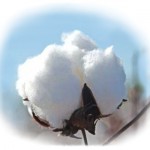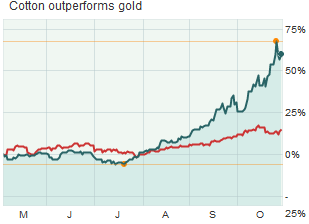Pima cotton, or Gossypium barbadense, is a luxury long-fiber cotton with a history of cultivation in Peru that spans centuries, if not millennia, and known to Peruvians as “gamuza,” which is Spanish for “suede.” The plant is most commonly named for the Pima Indians, who were the first to harvest the crop in the United States, but archeologists have traced Pima cotton’s genesis to South America, having found samples that date back to 3100 B.C.
Pima cotton has extra long fibers and is typically referred to as extra-long staple. The fiber length is 1-7/16 inch. If the fiber is at least 1-2/8 inch, then it falls into the ELS category–anything shorter and it is classified under another type.
Considerations
Egyptian cotton can be an ELS cotton; however, not all Egyptian cotton has long fibers. Most cotton exported from Egypt is not ELS. Even though Egypt is one of the largest producers of ELS cotton, it keeps most of it within the country. The sateen feature is a special weave that makes this sheet extra smooth to the touch.
Misconceptions
If you purchase Pima cotton, you know you are getting a long staple fiber, but you do not know if you are getting this with Egyptian cotton sateen. Pima cotton is softer then most other cotton varieties because it is roller ginned not saw ginned like shorter staple length cottons.
Thread Count
Cotton sateen is a very strong and resilient, giving it longer life then standard linens. Linens made with Pima cotton have a high thread count, usually from ranging from 250 to 600.
History
Pima cotton is grown in the U.S., Israel, Peru and Australia. The name, Pima, comes from the Pima Indian tribe that grew cotton in Arizona. Only three percent of the cotton grown in the U.S. is Pima because there is a select area where it can be grown.
BACKGROUND INFORMATION
While regular upland cotton is the seed coating of the plant Gossypium hirsutum, extra long staple (ELS) cotton is the product of a botanically different plant, Gossypium barbadense. Originating in Peru around 4200 BC, Gossypium barbadense traveled via the Caribbean and North America to Egypt where it arrived during the reign of Mohammad Ali Pasha in the early 19th century. Over years of painful selections with primitive methods the first commercially usable long staple variety called Mit Afifi emerged in 1882.
Another long staple variety developed in Egypt in the 19th century was Sakellaridis, which formed the basis for all long-staple varieties grown today in Central Asia, Sudan and the Xinjiang province of China.
Today ELS varieties are grown in a number of countries worldwide. The largest production centers are in Egypt, California and in the Western Chinese province of Xinjiang. Minor producing regions are India, the Central Asian Republics, Sudan, Israel, Peru and Australia. Textiles made out of ELS cotton are produced in many countries throughout the world by textile companies equipped to spin and weave this unique fiber. ELS cotton only represents three percent of total world cotton production, but consumers all around the world consider textiles made of ELS varieties as representing the very best quality.
Color Facts
 The Incas were especially well known for their practice of cultivating and weaving Pima cotton for both practical and artistic purposes. Like them, contemporary harvesters cultivate the crop by hand, which prevents the contamination of the cotton with the impurities that result from an industrial process, and leave a scratchy texture and yellowish cast. Hand-harvested Pima cotton, by contrast, results in a smooth, lustrously white finish—making it a perfect medium for Plumas to mix a variety of vibrant colors.
The Incas were especially well known for their practice of cultivating and weaving Pima cotton for both practical and artistic purposes. Like them, contemporary harvesters cultivate the crop by hand, which prevents the contamination of the cotton with the impurities that result from an industrial process, and leave a scratchy texture and yellowish cast. Hand-harvested Pima cotton, by contrast, results in a smooth, lustrously white finish—making it a perfect medium for Plumas to mix a variety of vibrant colors.
Pima Cotton in the News
Cotton prices (NY10Z 124.63, +3.58, +2.96%) have jumped more than 50% over the last three months. They reached record levels of around $1.30 per pound on the ICE Futures U.S. exchange Tuesday.
Gold (GCZ10 1,360, +15.10, +1.12%) recently touched a record level, too, on Oct. 14 at nearly $1,378 an ounce on Comex, though its 15% three-month gain pales in comparison to cotton’s.
Shrinking supplies and rising demand worldwide have contributed to cotton’s strength over the past several months.
“About three months ago, the market finally woke up to the fact that the stocks in China weren’t really there,” said Peter Egli, director of risk management at Plexus Cotton Ltd., suggesting that U.S. Department of Agriculture data didn’t accurately reflect Chinese stockpiles at the time.
What Makes Luxury Peruvian Pima Cotton So Special?
 Cotton is cotton – or is it? Stephen Yafa, in his book Cotton: the Biography of a Revolutionary Fiber, highlights the importance of length in any given species of cotton fiber. Luxury cotton is distinct from more common cottons in that the fibers are longer, and this distinction is vital. Yafa likens this to “the difference between perfectly drinkable table wine and a celestial Chateau Lafite-Rothschild”.
Cotton is cotton – or is it? Stephen Yafa, in his book Cotton: the Biography of a Revolutionary Fiber, highlights the importance of length in any given species of cotton fiber. Luxury cotton is distinct from more common cottons in that the fibers are longer, and this distinction is vital. Yafa likens this to “the difference between perfectly drinkable table wine and a celestial Chateau Lafite-Rothschild”.
Gossypium barbadense, or Pima cotton, is often categorized as an ELS cotton, or Extra Long Staple. Pima cotton fibers can be more than double the length of standard cottons, a fact that gives Pima cotton some distinct and desirable qualities.
The “Peruvian Connection”, specialist sellers of Peruvian clothes and fabrics, emphasize this special quality of Pima cotton on their website: “Because of its exceptional 1-3/8″ staple length (ordinary cotton fibers measure 1/2″ to 3/4″), Peruvian pima cotton is silky soft, durable, and highly resistant to pilling”.Products made from Pima cotton are much stronger than products made of upland cotton. Pima cotton’s strength helps to improve any finished product’s durability and give it a longer life.
Pima cotton, is extremely fine which allows more fibers to be spun into cloth. The more fibers in a cloth, the higher the thread count. And with a higher thread count comes greater softness.
Not all Egyptian cotton is extra-long staple, unlike Pima cotton. For cotton to earn the name Pima, it must measure be extra-long staple, but the label Egyptian cotton only guarantees that the cotton was made in Egypt. Egypt consumes the majority of cotton it produces, leaving it unable to keep up with worldwide demand. This lack of Egyptian supply helps create an ever-growing demand for Pima cotton.
Pima History to Modern Day
History
In the tradition of Mark Kurlanskyas “Cod” and “Salt,” this endlessly revealing book reminds us that the fiber we think of as ordinary is the worldas most powerful cash crop, and that it has shaped the destiny of nations. A sweeping chronicle of ingenuity, greed, conflict, and opportunism, “Cotton” offers aa barrage of fascinating informationa (“Los Angeles Times”).
Peruvian Pima Cotton Today – Gossypium Barbadense in Modern Peru
Peruvian Pima cotton is cultivated today in the Northern coastal valleys of Piura and Chira, as it has been for thousands of years. The climate and soil conditions here are perfect, with ideal seasonal rainfall and temperatures.
While modernization of the Peruvian Pima cotton growing process has obviously occurred, many plantations still harvest the cotton by hand. This further enhances the general quality of Peruvian cotton. Hand-picking leads to fewer imperfections in the yarn giving an even softer finish. It is also a more environmentally friendly process.
Machine harvesting can scratch the cotton and taint the color resulting in an inferior product. According to Swicofil.com, “About 30% of world cotton is harvested by machines. Australia, Israel and USA are the only countries where all cottons are picked by machines”.
Peruvian Pima cotton deservedly claims the title of “luxury cotton”. Not only does gossypium barbadense provide a higher quality fiber, the harvesting methods found in Peru result in a finer finish worthy of the rich history of Peruvian cotton.
Sources:
Yafa, Stephen – Cotton: the Biography of a Revolutionary Fiber, Penguin, 2005, ISBN 0143037226
Read more at Suite101: Peruvian Pima Cotton – Gossypium Barbadense: Native South American Luxury Textiles of Peru & Inca Civilization http://www.suite101.com/content/peruvian-pima-cotton-gossypium-barbadense-a149601#ixzz13rGjcj4Z

